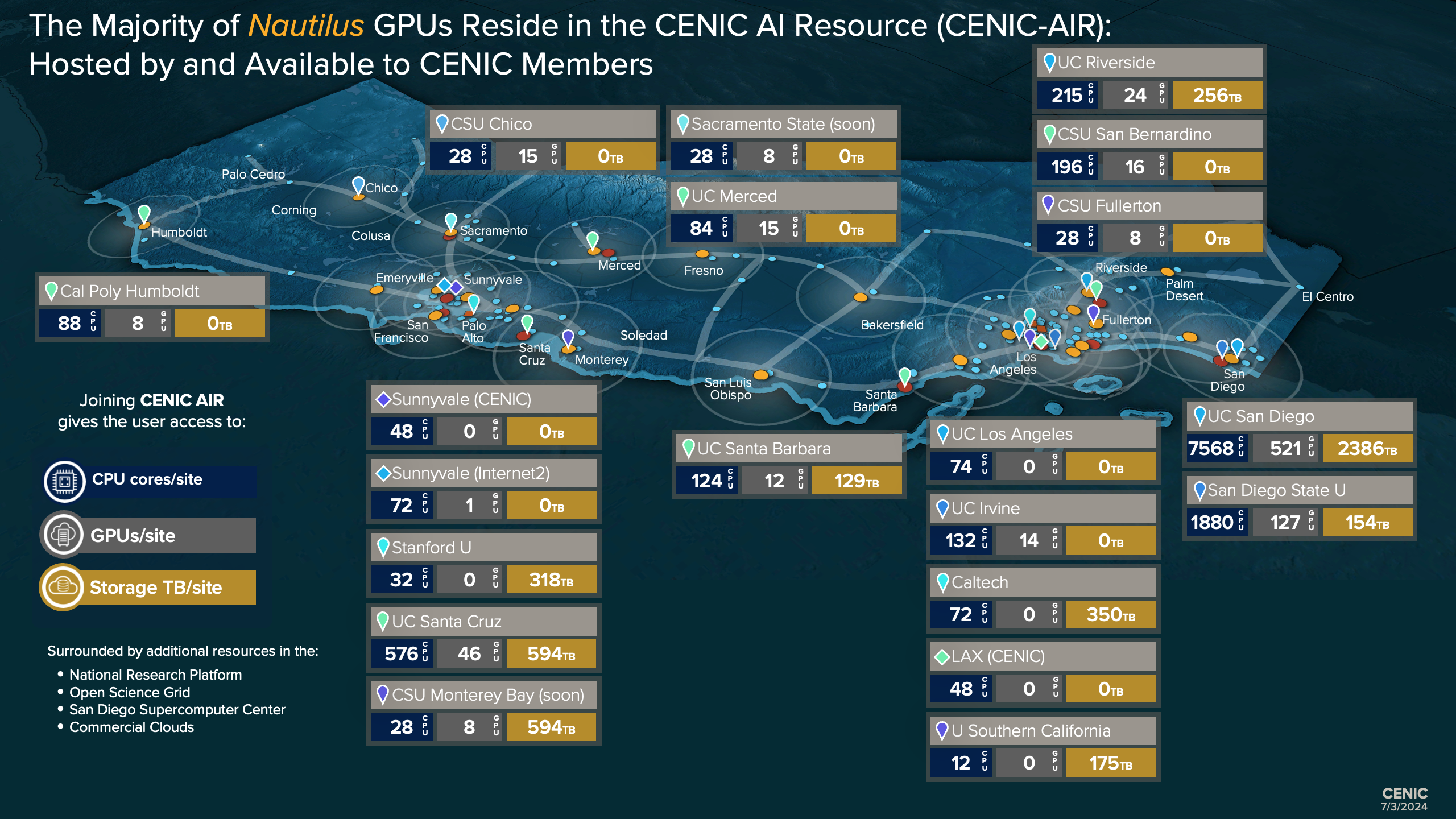- About
- Network
- Community
- Initiatives
- News
- Events
- Blog
- Publications

San Diego State University’s VERNE: Applying the CENIC AI Resource to Multi-disciplinary Instruction
Categories AI/Machine Learning CSU The CENIC Community
Tags CENIC AIR
Machine Learning and Artificial Intelligence (AI) are opening new career paths for students at all levels in both the private sector and academic arena. Students need open-access, scalable AI research and instructional resources if California’s research and education community is to remain an AI industry leader and maintain its leadership position during this transformation.
When teaching courses in AI and machine learning, as well as other data-heavy disciplines like computer engineering, computer science, data science, and software engineering, San Diego State University faculty have led the charge in finding new, innovative solutions.
SDSU Meeting the Challenge with VERNE
To meet this challenge, SDSU made an institutional investment in a computing cluster for instructional use called the Visionary Education Research Network Environment (VERNE), offering advanced graphical processing units (GPUs) and storage made available via JupyterHub, an easy-to-use web-based environment for accessing these resources.
“SDSU’s institutional investment in VERNE is one element of its AI and machine learning strategy. SDSU’s fall 2023 survey of students on AI found that 71% believe AI will become an essential part of most professions,” said James Frazee, SDSU interim Vice President for Information Technology and Chief Information Officer.
“While not all students will learn AI and machine learning techniques, those who do will need access to resources to learn these crucial skills,” Frazee said. “VERNE provides faculty and students with access to these resources to support teaching and student-based research, equipping students for career success.”
Since Spring 2023, VERNE has supported over 20 courses and served over 600 students across a wide array of disciplines, including astronomy, cybersecurity and defense, mathematics, and text analysis.
“AI has been rapidly advancing in complexity and computational demands. Before VERNE we could only develop assignments and course material that could run on a standard student laptop which excludes the latest advancements in AI. Now our AI and analytics classes can remain cutting edge and give students valuable experience with high end enterprise hardware and software,” said Aaron Elkins, director of the James Silberrad Brown Center for Artificial Intelligence at SDSU.

Uduak George, SDSU associate professor of mathematics and statistics, is using VERNE in her Cancer Health Equity and AI Research Lab, specifically leveraging computational analysis and machine learning to characterize chronic obstructive pulmonary disease (COPD) susceptibility.
"Being able to provide students with access to advanced resources including GPUs from any web browser is a great benefit to instruction. These are resources that may not otherwise be available or out of reach for a single class here at SDSU," said George. "I have expanded my use of VERNE for a project funded by the National Institutes of Health's Artificial Intelligence/Machine Learning Consortium to Advance Health Equity and Researcher Diversity (AIM-AHEAD) where we are looking at understanding COPD by looking at the development of the lungs along with environmental exposures and how those affects susceptibility to COPD later on in life."
VERNE Enhances Instruction via the CENIC AI Resource
VERNE is part of the CENIC AI Resource (CENIC AIR), the California portion of the nationwide National Research Platform (NRP) Nautilus distributed cluster. As part of NRP, users of CENIC AIR can make use of the entire national-level NRP infrastructure and collaborate with its community of users.

At the core of NRP is Nautilus: a large, distributed compute and storage cluster optimized to run data science/AI applications. Institutions voluntarily contribute to Nautilus’ hardware and software, becoming co-owners. These resources are interconnected and accessed via regional and national research and education networks such as CENIC’s CalREN and Internet2.
VERNE, for example, consists of 15 Dell PowerEdge servers each offering students and faculty 8 servers with 4 GPUs each and 4 CPU servers, along with 480 Terabytes of adjacent storage. To minimize latency and maximize performance without impacting other campus data traffic, these resources are made available for use via a Science DMZ network that routes their traffic on and off campus via a separate high-performance network path.
There is no cost to utilize NRP resources for research and education use. When institutions add resources to NRP, they can provide their users with a guaranteed level of access, however users can still access NRP resources without their institution contributing on an “as available” basis. Participating in CENIC AIR, and beyond that to NRP, does not require CalREN-HPR connectivity, but for institutions looking to host Nautilus servers, CENIC offers reference architectures and engineering support.
The Future of VERNE and of Instruction Itself
At SDSU, VERNE usage has steadily increased each semester since launching in Spring 2023, beginning with two courses, then six in Fall 2023, and thirteen in the most recent Spring 2024 semester. With AI and machine learning interest increasing in all domains, it’s critical that students are given access to resources to make them competitive in today’s workforce.
Related blog posts
CENIC and San Diego Supercomputer Center Create Sustainable Agriculture for California’s Future
CENIC’s networking and services, including CENIC AIR, can be a vital part of preparing new generations of farmers that will apply the latest technology to agriculture by turning the farm into an educational setting and improving the efficiency of farming as a career.
CENIC Members Enable Data-Driven Agriculture: Optimizing Harvests in a Changing Environment
The use of technology in agriculture to increase yield and decrease resources is the focus of an innovative project fueled by CENIC and its collaborative partners: a novel model of precision agriculture in the vineyards.


